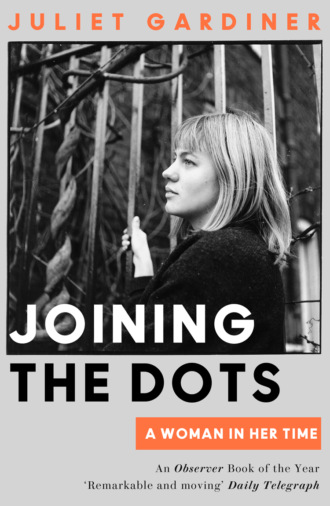
Полная версия
Joining the Dots: A Woman In Her Time
Herbie Gates was one of the church wardens at St Mary’s Church, Hemel Hempstead, where my mother went to matins every Sunday and was a member of the Mothers’ Union. Before the war he had sometimes helped with the heavy work in our garden, but during the war he had volunteered for Civil Defence duties, becoming an ARP warden, a responsibility he had taken very seriously, even officiously. ‘Little ’itler’ was murmured as he admonished ‘Put out that light!’ to householders demonstrating inadequately observed blackout. Now that he had handed back his brassard and tin hat, he too must be cut down to size, according to my mother and her neighbours, and put to setting potatoes, scything nettles and taking the church collection plate again, rather than having his wartime authority recognised as was surely his due.
It is not surprising that I have no memory of the war or its immediate aftermath, but what is surprising is that while I could read the signifiers of shortages and destruction, I had almost no factual knowledge until I was almost an adult about this cataclysmic event that would slice the twentieth century in two. No one I knew wanted to talk about the war that had gone on too long and too painfully and had put lives on hold for half a generation. There was no narrative of the war, though it was proffered as an explanation for many things, including the appearance one Sunday lunchtime of a neighbour who had been in a Japanese POW camp for three years, crawling on his stomach through the open French windows of his family home some months after his release, a knife clenched between his teeth as he threatened his wife and children.
Boys played cowboys and Indians, not Tommies and Nazis; we looked at maps of the British Empire in primary school, not the world at war. The Second World War was not on the syllabus at secondary school either, and nor was it offered as a topic when, much later, I went to read history at university.
There were soon plenty of books about the military aspects of war: battles, generals’ memoirs, discussions of causes, strategies and hardware. Cinema-goers too thrilled in time to such heroic films as The Wooden Horse and The Dam Busters. But the civilian experience remained largely unspoken. During the war, films such as Waterloo Road, Millions Like Us, Went the Day Well? and Mrs Miniver had filled cinemas with their subtle – and sometimes not so subtle – messages of propaganda and encouragement for the home front. Give your all for the war effort; pull together for victory; keep faithful and devote your energies to keeping your home happy and secure for when your fighting man returns. Immediately after the war, the dreariness of wartime sacrifice was not what cinema-goers wanted to be reminded of; the films they flocked to see were comedies, musicals, historical dramas and thrillers.
Richard Titmuss’s volume of the official history of the civilian war, Problems of Social Policy, came out in 1950 but it was not until the late 1960s that books for the general reader began to be published. Angus Calder’s The People’s War, the first – and to date the best – book on the civilian war in Britain, much influenced by Titmuss, was published in 1969, followed in 1971 by Norman Longmate’s history of everyday life in wartime Britain, How We Lived Then. The first of the twenty-six episodes of the epic series The World at War directed by Jeremy Isaacs was shown on ITV in October 1973. ‘Home Fires Burning: Britain’, the single episode on the civilian side of the war, written by Angus Calder, was transmitted on 13 February 1974.
There were many hard-working and courageous women who joined the forces in the war and gradually the great value of the Auxiliary Territorial Service (ATS), the Women’s Royal Naval Service (WRNS), the First Aid Nursing Yeomanry (FANYs), the Women’s Auxiliary Air Force (WAAFs) and the Women’s Land Army (WLA) was recognised, as was the story of the heroic women recruits to the SOE (Special Operations Executive). However, the contribution of women on the home front was slower to be acknowledged. This was in no way solely a women’s domain: think firefighters, Civil Defence and Observer Corps, medical staff and many more organisations which in most cases consisted of more men than women. Nonetheless, women did ‘keep the home fires burning’, in their own houses if their meagre coal rations stretched to it, but also on the land, in banks and offices, in munitions and aircraft factories, on buses, in postal services, as porters at railway stations, and in welfare and medical services.
Statues of Second World War generals and leaders strut on plinths throughout the country. Even the animals – horses, dogs, pigeons, mules – who served in various ways in wars had a monument erected at the edge of Hyde Park in 2004. But it was not until nearly a year later that a sombre bronze monument depicting the wartime uniforms women had worn, both military and civilian, hanging, discarded, from hooks, was unveiled in Whitehall close to the Cenotaph. Certainly I had no idea in those early postwar years of the professionalism and heroism that must have been displayed by the women around me. It was many years later, through my work as a historian, that I came to understand the texture of that time.
Конец ознакомительного фрагмента.
Текст предоставлен ООО «ЛитРес».
Прочитайте эту книгу целиком, купив полную легальную версию на ЛитРес.
Безопасно оплатить книгу можно банковской картой Visa, MasterCard, Maestro, со счета мобильного телефона, с платежного терминала, в салоне МТС или Связной, через PayPal, WebMoney, Яндекс.Деньги, QIWI Кошелек, бонусными картами или другим удобным Вам способом.




